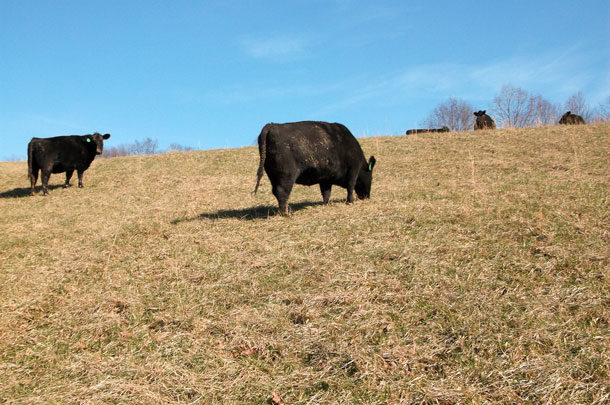Stockpiling forages, especially cool-season grasses for fall and winter grazing, is an excellent option – and now’s the time to consider it. All you need to do is make a final grazing of the field or final mowing and let it grow until later in the fall or winter. Typically, adding nitrogen when stockpiling is initiated will increase yield and quality.
If you live in an area with fescue, this is the forage that usually works best. Other grasses like orchardgrass work, but the quality and yield diminishes faster as winter weather settles in. We have conducted research in eastern Ohio periodically over the past 25-plus years, and we have consistently had increased yield and quality when nitrogen fertilizer was added, although not always statistically significant.
For example, in replicated trials at three locations in eastern Ohio last fall, there was a significant difference between the control (no fertilizer) and treatments of 100 pounds of urea, 100 pounds urea plus Agrotain and 219 pounds of ammonium sulfate (the three treatments were 46 actual pounds of nitrogen per acre) for yield and crude protein – but not among the treatments. The forages were predominantly fescue and orchardgrass pastures. The study was initiated on Aug. 2, 2016, and harvested on Nov. 4, 2016. There was no more than 0.1 inch of rainfall in the first 12 days of the trial and 3.2 to 5.85 inches of rain within 30 days. The control plots averaged 2,627 pounds dry matter per acre, and plots with nitrogen added averaged 3,144 to 3,694 pounds dry matter per acre. Crude protein averaged 13.19 percent for the control plots and 13.35 to 13.65 percent for the treatments. So we had improved yield and quality adding nitrogen.
What are some considerations for stockpiling? Do you have extra pasture or hayfields you can stockpile? Are you going to be short on stored feed this winter? Can you sell extra stored feed and stockpile? Will the cost of the fertilizer be more or less than purchased hay? Depending on weather conditions when stockpiling, and the availability and cost of purchased hay, sometimes buying hay could cost less.
How about other factors, such as the time needed to feed the hay compared to grazing the stockpiled forages? I know I save up to an hour each day when my cattle are on stockpiled forages compared to feeding hay every day. In many situations, the quality of the stockpiled forages may be better than hay. I know many producers who feed hay in the late summer while stockpiling because they will use less hay in a given year overall.
Another reason I like to stockpile is for calving season in March. I save a “high and dry” field stockpiled since last August, and not only am I done feeding hay three weeks early, but the cows have a thick sod to calve on – eliminating mud issues. The cows even seem to improve body condition once on the stockpiled fescue. However, I do feed a couple of pounds of shelled corn to each cow every day to provide a little extra energy. I also recommend a forage test prior to feeding that late in the season, as quality of the stockpiled fescue will decrease.
When considering stockpiling, think about time, costs and weather. I have already mentioned time saved not having to feed hay, but how about the time and cost of making hay? Generally speaking, it is three times more expensive to feed an animal than to make them graze it.
If you have the opportunity, I would stockpile, especially cool-season grasses like fescue. Depending on what part of the country you’re in, you can initiate stockpiling now through October. The earlier you begin, the higher the yield will be – but lower-quality when you begin grazing. The later you begin stockpiling, the quality will tend to be higher and the yield lower. If a soaking rain is forecasted within a couple of days, applying approximately 50 pounds of nitrogen in the form of urea will provide additional yield and quality. If no rain is forecasted in the near term, applying Agrotain will reduce chances of volatilization with urea. Ammonium sulfate worked well in the trials, even without rain, but the costs were approximately twice as much compared to urea.
Each year, I try to reduce the amount of hay I make and increase the amount of acreage I stockpile. My goal is to get down to only 60 days of feeding hay this year. A few farmers in southeast Ohio have gotten down to 30 days or less. I hope to eventually get there as well – and maybe get less frustrated putting up hay. ![]()

-
Chris Penrose
- Associate Professor and Extension Educator
- Ohio State University
- Email Chris Penrose
PHOTO: The author has found stockpiling is a great way to eliminate mud issues during calving season and to cut feed costs. Photo provided by Chris Penrose.









